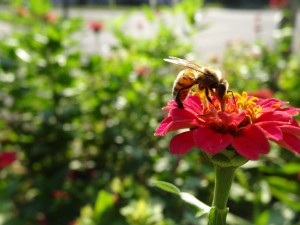31
Oct
USDA To Provide Additional $4 million for Honey Bee Habitat, No Mention of Pesticides
(Beyond Pesticides, October 31, 2014) Without any mention of the role of pesticides in bee decline, or emphasis on organic practices to help pollinators, Agriculture Secretary Tom Vilsack announced Wednesday that more than $4 million in technical and financial assistance will be provided to help farmers and ranchers in the Midwest improve the health of honey bees. The announcement renews and expands on a $3 million pilot investment last spring to create pollinator-friendly habitat in five Midwestern states.
 The effort responds to the Presidential Memorandum, which directs USDA to expand the acreage and forage value in its conservation programs. The Memorandum, issued at the close of National Pollinator Week 2014, directed federal agencies to establish a Pollinator Health Task Force, and tasked agency leads at the U.S. Department of Agriculture (USDA) and U.S. Environmental Protection Agency (EPA) to develop a pollinator health strategy within 180 days that supports and fosters pollinator habitat.
The effort responds to the Presidential Memorandum, which directs USDA to expand the acreage and forage value in its conservation programs. The Memorandum, issued at the close of National Pollinator Week 2014, directed federal agencies to establish a Pollinator Health Task Force, and tasked agency leads at the U.S. Department of Agriculture (USDA) and U.S. Environmental Protection Agency (EPA) to develop a pollinator health strategy within 180 days that supports and fosters pollinator habitat.
“The future of America’s food supply depends on honey bees, and this effort is one way USDA is helping improve the health of honey bee populations,” Vilsack said. “Significant progress has been made in understanding the factors that are associated with Colony Collapse Disorder and the overall health of honey bees, and this funding will allow us to work with farmers and ranchers to apply that knowledge over a broader area.”
An estimated $15 billion worth of crops is pollinated by honey bees, including more than 130 fruits and vegetables. USDA’s Natural Resources Conservation Service (NRCS) is focusing the effort on five Midwestern states: Michigan, Minnesota, North Dakota, South Dakota and Wisconsin. According to USDA, the Midwest is home to more than 65 percent of the commercially managed honey bees in the country from June to September. Thus, it is a critical time when bees require abundant and diverse forage across broad landscapes to build up hive strength for the winter.
While the creation of pollinator-friendly habitat is important for bee populations, the expansion of this project does not challenge the use of systemic pesticides that are linked to pollinator decline, or the widespread adoption of genetically engineered crops with elevated use of herbicides that kill habitat.
Bees and beekeepers are in dire need of protection from the effects of systemic neonicotinoid pesticides. Neonicotinoids are a relatively new class of insecticides that share a common mode of action that affect the central nervous system of insects, resulting in paralysis and death. They include imidacloprid, acetamiprid, clothianidin, dinotefuran, nithiazine, thiacloprid and thiamethoxam. Currently, neonicotinoid insecticides are the most widely used class of insecticides in the world and comprise about 25% of the global agrichemical market.
Neonicotinoids are systemic, meaning that as the plant grows the pesticide becomes incorporated into the plant. When honey bees and other pollinators forage and collect pollen or nectar, or drink from what are termed “guttation” (water) droplets emitted from neonicotinoid-incorporated crops, they are exposed to sublethal doses of the chemical. At this level, the pesticides don’t kill bees outright. Instead, they impair bees’ ability to learn, to find their way back to the hive, to collect food, to produce new queens, and to mount an effective immune response. Indeed, studies have found that “near infinitesimal” exposures to neonicotinoids causes a reduction in the amount of pollen that bumblebees are able to collect for their colony.
Conservation practices that USDA will provide help implementing include planting cover crops or rangeland and pasture management to reduce erosion, increasing soil health, inhibiting invasive species, and providing quality forage and habitat for honey bees and other pollinators. While many of these practices and benefits can be found in organic practices, it is not explicitly mentioned. Beyond Pesticides supports organic agriculture as effecting good land stewardship and a reduction in hazardous chemical exposures for workers on the farm. The pesticide reform movement, citing pesticide problems associated with chemical agriculture, from groundwater contamination and runoff to drift, views organic as the solution to a serious public health and environmental threat. To attract beneficial insects like monarchs and protect their habitats in your own backyard, there are several steps you can take. Like any other living organisms, pollinators need food, water, and shelter in order to thrive. For more information, see Managing Landscapes with Pollinators in Mind.
For more information on how to improve pollinator health and habitat, see the BEE Protective webpage, where you can find the Pollinator Friendly Seed and Nursery Directory, which lists sources of seeds and plant starts that are safe for bees and not poisoned with neonicotinoids or other pesticides. And join in on National efforts to push the marketplace towards pollinator friendly practices by delivering a card to Lowe’s this Halloween, asking the retailer to stop selling poisoned plants and bee-killing pesticides.
For more on technical and financial assistance available through USDA’s conservation programs, visit www.nrcs.usda.gov/GetStarted or a local USDA service center.
Source: USDA Press Release
Photo Source: Susan Jergen , WI
All unattributed positions and opinions in this piece are those of Beyond Pesticides.










